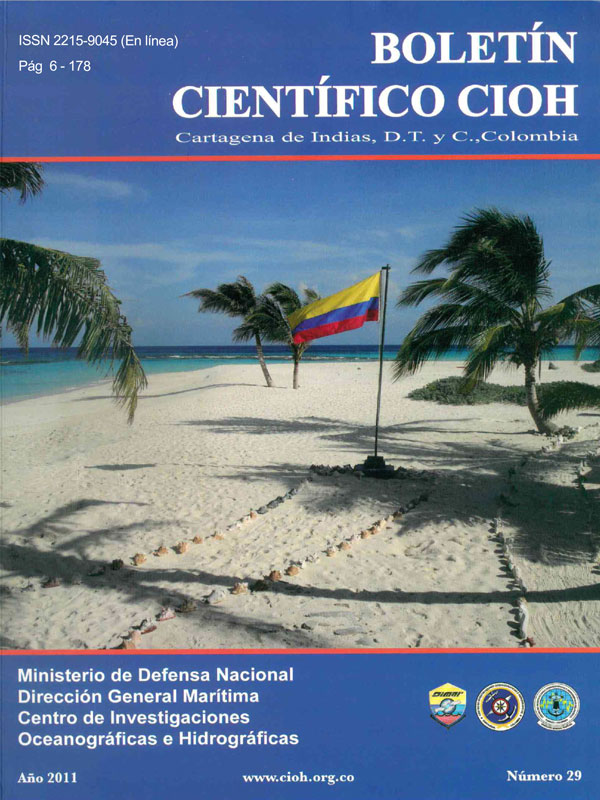Resultados del estudio de aguas de lastre en la Bahía de Tumaco (Colombia) – El terminal de multiboyas Ecopetrol
DOI:
https://doi.org/10.26640/22159045.237Keywords:
Shipping, ballast water, zooplankton, phytoplankton, introduction of organisms, alien species, Tumaco BayAbstract
The transfer of harmful organisms by shipping, in particular through the ballast water transport, can result in a disruption of ecosystems, change of biodiversity, negative impacts on human health and economic loss. The introduction of species that produce irreversible consequences in the receiving environments and economies require special attention. One critical issue is the need to assess the amount and processes of species introductions. Therefore, at the terminal Ecopetrol Buoyage at Tumaco Bay (Colombia), 18 vessels in international traffic were sampled, as well as two reference sites for comparison. The phytoplankton and zooplankton of the samples were analyzed and the physicochemical parameters of both the ballast water tanks and reference sites were evaluated. The results can be considered as background information for an initial risk assessment of species introductions in the future and as an important tool for the implementation of measures for ballast water management.Downloads
References
[2] Williams RJ, Griffi ths FB, Van der Wal EJ, Kelly J. Cargo vessel ballast water as a vector for the transport of nonindigenous marine species. Estuar. Coast. Shelf Sci. 1988; 26, 409–420.
[3] Gollasch S, Lenz J, Dammer M, Andres HG. Survival of tropical ballast water organisms during a cruise from the Indian Ocean to the North Sea. J. Plankton Res. 2000a; 22, 923–937.
[4] Gollasch S, Rosenthal H, Botnen H, Ha-mer J, Laing I, Leppa ̈koski E, Macdonald E, Minchin D, Nauke M, Olenin S, Utting S, Voigt M, Wallentinus I. Fluctuations of zooplankton taxa in ballast water during short-term and long term oceangoing voyages. Int. Rev. Hydrobiol. 2000c; 85, 597–608.
[5] Olenin S, Gollasch S, Jonusas S, Rimkute I. En route investigation of plankton in ballast water on ship’s voyage from the Baltic Sea to the open Atlantic coast of Europe. Int. Rev. Hydrobiol. 2000; 85, 577–596.
[6] Ruiz GM, Rawlings TK, Dobbs FC, Drake LA, Mullady T, Huq A, Colwell RR. Global spread of microorganisms by ships – ballast water discharged from vessels harbours a cocktail of potential pathogens. Nature. 2000; 408 (49–50 NOV 2).
[7] Gollasch S. The importance of ship hull fouling as a vector of species introductions into the North Sea. Biofouling. 2002; 18, 105–121.
[8] Coutts ADM, Kirrily MM, Chad LH. Ships’ seachests: an overlooked transfer mechanism for non – indigenous marine species. Mar. Pollut. Bull. 2003; 46 (11), 1510–1513.
[9] Gollasch S. German ballast water sampling manual. 1st International Workshop on Guidelines and Standards for Ballast Water Sampling. GloBallast Monography. Series No. 9, IMO London. 2003, 38 – 45 p.
[10] Jiménez R. Acta Oceanográfica del Pacífico. Diatomeas y Silicoflagelados del fitoplancton del golfo de Guayaquil. Guayaquil, Ecuador: INOCAR, 1983.
[11] Pesantes F. Acta oceanográfica del Pacífico. Dinoflagelados del fitoplancton del golfo de Guayaquil. Segunda edición. Ecua-dor: INOCAR, 1983.
[12] Tomas CR. Marine phytoplankton. A Guide to Naked Flagellates and Coccolithophorids. San Diego, USA: Editorial Academic Press Inc; 1983.
[13] Tomas CR. Identifying marine phyto-plankton. San Diego, USA: Editorial Academic Press Inc; 1997.[14] Uribe Palomino HJ. Colección fotográfica de organismos fitoplanctónicos de la cuenca del Pacífico colombiano. 2006.
[15] Boltovskoy D. Atlas del Zooplancton del Atlán-tico Sudoccidental y Métodos de Trabajo con el Zooplancton Marino. Mar de Plata, Argentina: Publicación especial del INIDEP; 1981.
[16] Dawson JK, Knatz G. Illustrated key to the planktonic copepods of San Pedro Bay, Ca-lifornia. Los Angeles: Allan Hancock Foundation; 1980. Tech. Rep, 2: 1-106.
[17] Newell GE, Newell RC. Marine plankton. A practical guide. London: Hutchinson Edu-cational; 1963.
[18] Riley JP. The Spectrophotometric Determination of amonia in natural water with particular reference to sea-water. Anal. Chim. Act. 1953; 9: 575-589.
[19] Strickland JDH, Parsons TR. A practical handbook of seawater analysis. Otawa. Fish. Res. Board of Canadá. Segunda Edi-ción, 1972.
[20] Murphy J, Riley JP. A modified single solution method for the examination on phosphate in natural water. Anal. Chim. Acta. 1952; 27: 31-36.
[21] Shinn MB. A colorimetric method for the determination of Nitrite. Ind. Eng. Chem. Anal. Ed. 1941; 13 (1): 33-35.
[22] Bendschneider K, Robinson, R. A New Spectrophotometric Method for the Determination of Nitrite in Sea Water. J. Mar. Res. 1952; 11: 87 – 96.
[23] Richards FA, Thompson TJ. The estimation and characterization of plankton populations by pigment analisys. II. A spectrophotometric methods for the estimation of plankton pigment. J. Mar. Res. 1952; 156-172.
[24] Drake LA, Ruiz GM, Galil BS, Mullady TL, Friedman DO, Dobbs FC. Microbial ecology of ballast water during a transoceanic voyage and the effects of open ocean ex-change. Mar. Ecol. Prog. Ser. 2002; 233, 13–20.
Downloads
Published
Issue
Section
License
Attribution — You must give appropriate credit, provide a link to the license, and indicate if changes were made. You may do so in any reasonable manner, but not in any way that suggests the licensor endorses you or your use.
NonCommercial — You may not use the material for commercial purposes.
NoDerivatives — If you remix, transform, or build upon the material, you may not distribute the modified material.
No additional restrictions — You may not apply legal terms or technological measures that legally restrict others from doing anything the license permits.



